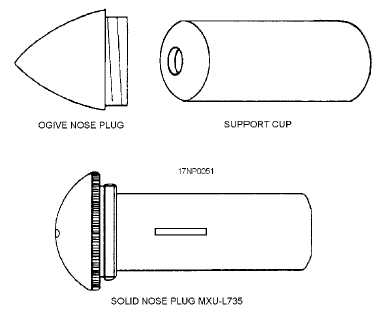NOSE PLUGS
There are two basic nose plugs (fig. 1-17) used in
general purpose bombs, the solid nose plug
(MXU-735/B and MXU-735A/B) and the ogive nose
plug. The ogive nose plug provides a pointed arch. A
support cup is used in the nose well with the ogive nose
plug to provide a solid structure to the bomb. The
MXU-735 solid nose plug is designed to provide better
penetration of hard targets, without the likelihood of
nose plug shearing during oblique impact. The
MXU-735 replaces the ogive nose plug and support
cup.
IDENTIFICATION
The high-explosive filler of the bomb (H-6) is
identified by the yellow stenciled nomenclature on the
bomb body and yellow band(s) around the nose. The lot
number is stenciled in white ink on the forward end of
the bomb. All Mk 80 (series) general-purpose bombs
currently being used aboard ships are required to be
thermally protected. Thermally protected Mk 80 series
bombs can be identified by the words THERMALLY
PROTECTED in the identification legend, a bumpy
exterior surface, and two yellow bands around the nose.
ARMING WIRE ASSEMBLIES
Arming wire assemblies (fig. 1-18) are used for
arming procedures during ordnance evolutions. The
primary function of arming wire assemblies is to
maintain ordnance components in a safe condition until
actual release of the bomb from the aircraft.
Normally, the wires consist of one or two brass or
steel metal strands attached to a swivel loop. Safety
Fahnstock clips (fig. 1-18) or safety clips, MAU 166,
are attached to the ends of the arming wires after
installation. They prevent premature or accidental
withdrawal of the arming wires from the component.
NOTE: Safety clips are used vice Fahnstock
clips unless otherwise specified.
Normally, arming wire assemblies are shipped in
spiral-wound fiber tubes, over packed in a wooden box.
Generally, the safety Fahnstock clips are packed in the
tubes with the arming wires. The most commonly used
arming wire assemblies are listed in table 1-3.
Arming wire installation procedures are discussed
in the TRAMAN where the use of arming wire
assemblies is required.
FIN ASSEMBLIES
Fin assemblies, used with the Mk 80 (series) LDGP
bombs, provide stability to the bomb. They cause the
bomb to fall in a smooth, definite curve to the target,
instead of tumbling through the air.
The fin assemblies, except the MAU-91A/B, are
shipped on metal pallets. Each individual fin is crated in
a lightweight, disposable metal crate (fig. 1-19). Some
fin assemblies are shipped with bomb lugs attached to
the shipping crate, depending upon the particular Navy
Ammunition Logistics Code (NALC).
Two types of fins are described in this part of the
TRAMAN—conical and Snakeye. The conical fin is
1-20
Figure 1-17.—Nose plugs.



